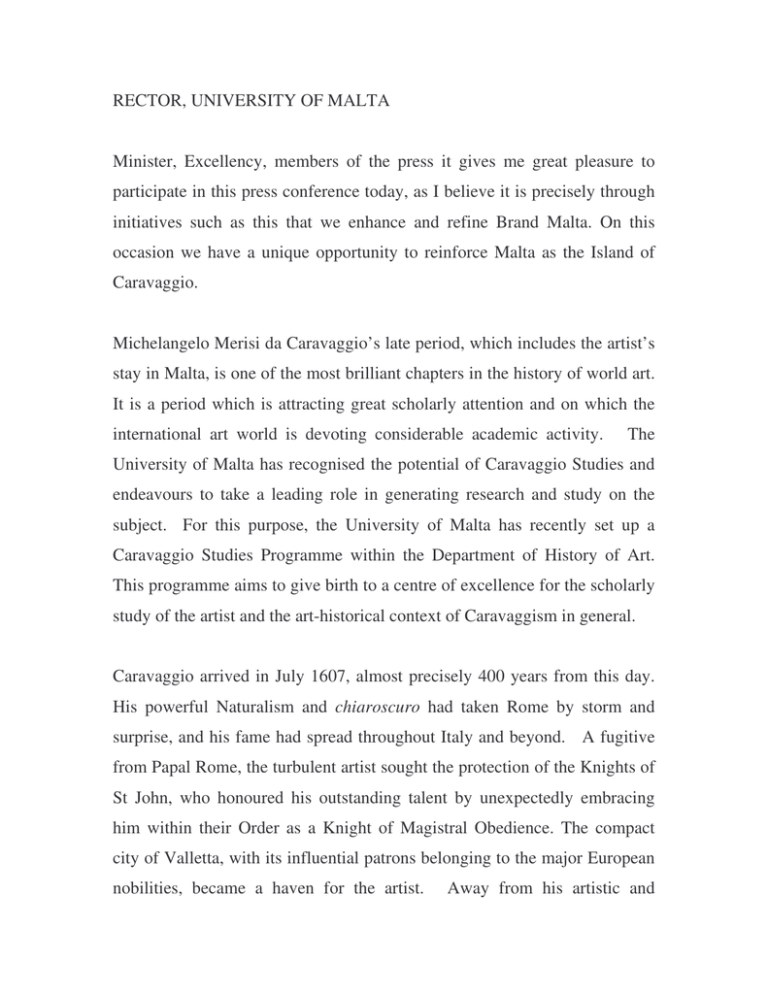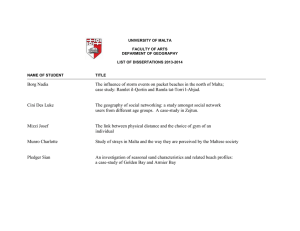RECTOR, UNIVERSITY OF MALTA
advertisement

RECTOR, UNIVERSITY OF MALTA Minister, Excellency, members of the press it gives me great pleasure to participate in this press conference today, as I believe it is precisely through initiatives such as this that we enhance and refine Brand Malta. On this occasion we have a unique opportunity to reinforce Malta as the Island of Caravaggio. Michelangelo Merisi da Caravaggio’s late period, which includes the artist’s stay in Malta, is one of the most brilliant chapters in the history of world art. It is a period which is attracting great scholarly attention and on which the international art world is devoting considerable academic activity. The University of Malta has recognised the potential of Caravaggio Studies and endeavours to take a leading role in generating research and study on the subject. For this purpose, the University of Malta has recently set up a Caravaggio Studies Programme within the Department of History of Art. This programme aims to give birth to a centre of excellence for the scholarly study of the artist and the art-historical context of Caravaggism in general. Caravaggio arrived in July 1607, almost precisely 400 years from this day. His powerful Naturalism and chiaroscuro had taken Rome by storm and surprise, and his fame had spread throughout Italy and beyond. A fugitive from Papal Rome, the turbulent artist sought the protection of the Knights of St John, who honoured his outstanding talent by unexpectedly embracing him within their Order as a Knight of Magistral Obedience. The compact city of Valletta, with its influential patrons belonging to the major European nobilities, became a haven for the artist. Away from his artistic and personal rivals, Caravaggio reflected on his art and also sought political alliances that would help him achieve his ultimate objective of setting foot once more in Rome. Within the charged and dramatic context of his life, Caravaggio’s stay in Malta initially provided the artist with a moment of tranquility, a period when the artist contemplated on both his life and his work. Some of the greatest works of his career were painted for the Knights of St John, including the magnificent Beheading of Saint John the Baptist, the St Jerome (both at St John’s Co-Cathedral, Valletta), and the Portrait of a Knight (Palazzo Pitti, Florence) which is the subject of today’s press conference. The picture will be brought to Malta in October 2007 to form part of the exhibition “Caravaggio and Paintings of Realism in Malta” organised by the Foundation for St John’s Co-Cathedral. The fruit of University’s academic collaboration with international institutions has been fundamental in concluding the loan of the painting with the Galleria Palatina at Palazzo Pitti in Florence. The painting will be delivered to Malta through the management and direction of the Malta Council for Culture and the Arts and support of the Embassy of Italy in Malta. The University of Malta, through Dr Keith Sciberras, is co- ordinating scholarship and research activity for this exhibition. This project sees the involvement of leading international scholars. The University of Malta’s Caravaggio Studies Programme undertakes, promotes, facilitates and coordinates research and study on the artist and artists influenced by him. It uses the resources of the University and has a specialised library on the artist which is currently being set up with the help of international benefactors. The University of Malta has a strong academic affiliation with international scholars and institutions and has organised, participated, and collaborated in lectures, conferences, and exhibitions on the subject, including the recent milestone exhibitions in London, Naples, and Milan. Its research work has been published in leading journals, scholarly books, and exhibition catalogues. This said, our work at University is greatly enhanced by the collaboration and support of others. On this occasion, I would like to thank the Malta Council for Culture and the Arts and the Ambassador of Italy to Malta for their assistance and the Foundation for St. John’s Co-Cathedral for its endeavours and collaboration. A final note of thanks goes to Professor Buhagiar and Dr. Keith Sciberras from the University of Malta History of Art Department for their initiative and tireless promotion of our artistic heritage. Juanito Camilleri




